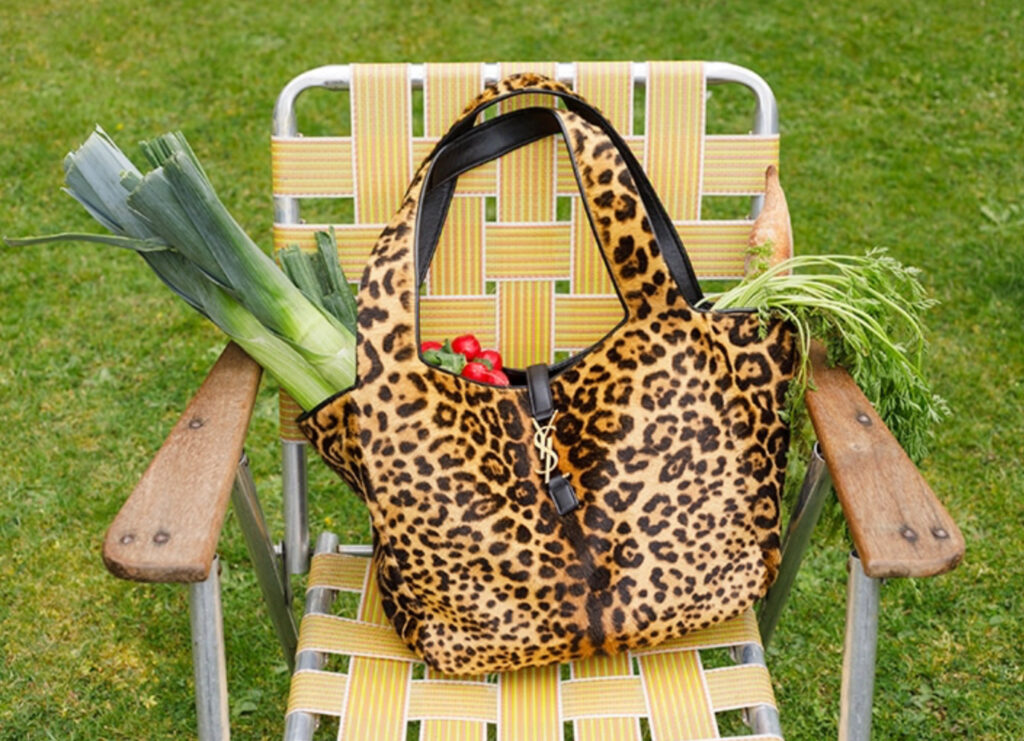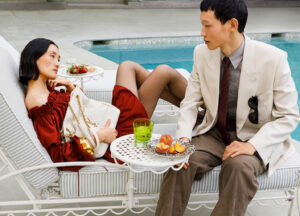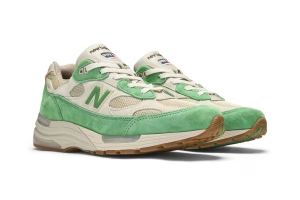In a fashion world where pristine lighting and aspirational glamour remain the industry’s lingua franca, Saint Laurent’s latest visual offering defies expectation with biting precision. Titled An Ordinary Day, the campaign sees Anthony Vaccarello tapping the sharp lens of British photographer Martin Parr, known for his decades-long obsession with the banal, the awkward, and the everyday. The result is a deliberately jarring juxtaposition: exquisitely tailored silhouettes perched amidst fluorescent-lit cafes, garishly tiled bathrooms, and the quiet absurdity of life’s in-between moments. More than a campaign, An Ordinary Day is a visual essay — a meditation on luxury, irony, and what it means to look beautiful in a world increasingly obsessed with being seen.
The Anti-Glamour Instinct
Martin Parr is not the kind of photographer who captures beauty in its traditional sense. His is a world of overexposure, unflattering flash, and uncomfortable proximity. Since the 1980s, Parr has chronicled British working-class leisure, supermarket culture, seaside holidays, and the performance of daily life with a caustic wit that straddles affection and critique. His images are often misread as cruel, but they are more accurately described as confrontational. They hold up a mirror to the viewer and ask: Isn’t this also who you are?
This ethos finds fertile ground in Vaccarello’s evolving vision for Saint Laurent. Since taking the reins in 2016, Vaccarello has infused the house’s legacy of sleek sensuality with a darker, more architectural edge. His Saint Laurent woman is statuesque, but restless — seductive, but never entirely still. There’s a rigor to his silhouettes, a sense of restraint that never slips into minimalism. By placing these powerful figures in Parr’s deliberately drab worlds, An Ordinary Day reveals the fragility of fashion’s curated fantasy. The Saint Laurent clothes remain undeniably gorgeous, but they’re no longer elevated by context — they are complicated by it.
The Politics of Context
One image from the series shows a model, all sharp cheekbones and shoulder pads, standing against a laminate countertop as a microwave hums behind her. Another sits, knees tightly crossed, on a plastic chair in a local hair salon, an expression of vague irritation stretched across her face. There’s a model leaning against a mustard-painted radiator, another perched beside an old television set in a floral living room that screams suburban detritus.
Parr’s hyper-saturated palette and clinical framing render these scenes almost too real — and therein lies the tension. Fashion photography has long relied on the illusion of escapism. Even when shot on location, the emphasis is on transfiguration. But here, the clothes do not liberate the subjects from their environment. Rather, the environment pushes back, reminding us that even the most curated look exists within — and is affected by — space, time, and circumstance.
Vaccarello’s intent is clear: strip away the exoticism, and what remains of luxury? Can a Saint Laurent blazer still feel powerful when worn in a laundromat? The campaign doesn’t answer so much as it insists we ask again.
Ordinary as Subversion
In recent years, fashion has increasingly flirted with the ordinary. The rise of “normcore” in the early 2010s marked a pivot toward plainness as a subcultural style, while brands like Balenciaga, Vetements, and even Gucci under Alessandro Michele weaponized irony through absurd casting and intentionally mundane backdrops. But Parr’s approach — and by extension, Vaccarello’s — operates on a deeper level. It isn’t about satire or social media-friendly mockery. An Ordinary Day isn’t funny in the way a dad sneaker or $800 IKEA bag might be. It’s disquieting. It asks what happens when luxury becomes indistinguishable from the scene around it — when it no longer transcends.
There’s a scene in one of the campaign’s short films where a model sips instant coffee while clad in a sheer blouse and towering stilettos. The incongruity isn’t just visual — it’s emotional. One feels the weight of silence, of pause. These are not the heightened poses of couture editorials; they’re micro-dramas of daily drift. Parr’s subjects, even when styled to perfection, seem preoccupied, lonely, bored. Their lives do not revolve around their outfits.
And this, ultimately, may be the campaign’s most radical gesture: to decenter fashion from itself. Where most campaigns shout “look at me,” An Ordinary Day whispers, “but what else?”
Photography as Anthropology
Parr has long blurred the line between art and social science. A member of Magnum Photos since 1994, his work has been featured in both blue-chip galleries and public libraries. His lens does not discriminate. He documents the material culture of the everyday — sandwiches, swimsuits, tanned flesh, tourist traps — with the same attention a scholar might apply to ancient artifacts.
In collaborating with him, Vaccarello invites fashion into this lineage of visual anthropology. The campaign becomes a kind of sartorial field study: How does the Saint Laurent silhouette operate in unglamorous terrain? What does it mean for a model to be poised, but purposeless? The result is a new form of fashion storytelling — one that resists narrative closure and embraces contradiction.
Crucially, this collaboration avoids the trap of condescension. While Parr’s critics have accused him of punching down, his most compelling images often reveal how people use clothing — however humble — to construct identity, assert presence, and find meaning. In that sense, An Ordinary Day is a celebration of dress as language, not just ornament.
The Power of Ambivalence
One of the most striking aspects of An Ordinary Day is its refusal to offer emotional clarity. There are no smiles here, but no overt distress either. The models are captured mid-thought, mid-bite, mid-blink — fragments of unscripted experience. They are not performing for the camera so much as existing in spite of it.
This sense of emotional ambiguity speaks to a larger shift in fashion communication. As audiences grow weary of polished perfection, there’s an increasing appetite for discomfort, for work that leaves something unresolved. Parr’s images, with their forensic detail and emotional opacity, are ideal vehicles for this new aesthetic of uncertainty.
Vaccarello seems to understand that true luxury now lies not in control, but in surrender — to context, to chaos, to the unpredictable rhythms of life. In An Ordinary Day, beauty is not imposed but negotiated.
Legacy and Lineage
This campaign does not exist in a vacuum. It echoes earlier moments in fashion history where the ordinary was used as a canvas for reinvention. From Juergen Teller’s anti-editorial editorials for Marc Jacobs in the 1990s to Corinne Day’s controversial work with Kate Moss, fashion has periodically turned to realism as both a provocation and a refresh.
But Parr’s lens brings a different energy — one rooted in documentary tradition, not art school rebellion. His presence signals a deeper commitment to questioning not just how fashion looks, but how it functions in the wild.
Moreover, by engaging a photographer known for his critical stance on consumerism, Vaccarello shows a rare willingness to interrogate his own industry. An Ordinary Day is not satire. It’s self-reflection. It doesn’t mock luxury; it questions its terms.
Impression
In a world oversaturated with images, where every street corner becomes a backdrop and every meal a photo-op, An Ordinary Day offers a visual language that resists spectacle. It is a campaign about the limits of fantasy — and the power of proximity.
By placing Saint Laurent garments in quotidian settings, Vaccarello and Parr remind us that fashion is not confined to runways or red carpets. It is lived. It creases, wrinkles, stains. It enters rooms that smell of reheated soup. It sits in silence. It watches TV.
And in those moments, it becomes something far more interesting than aspiration. It becomes real.
No comments yet.










